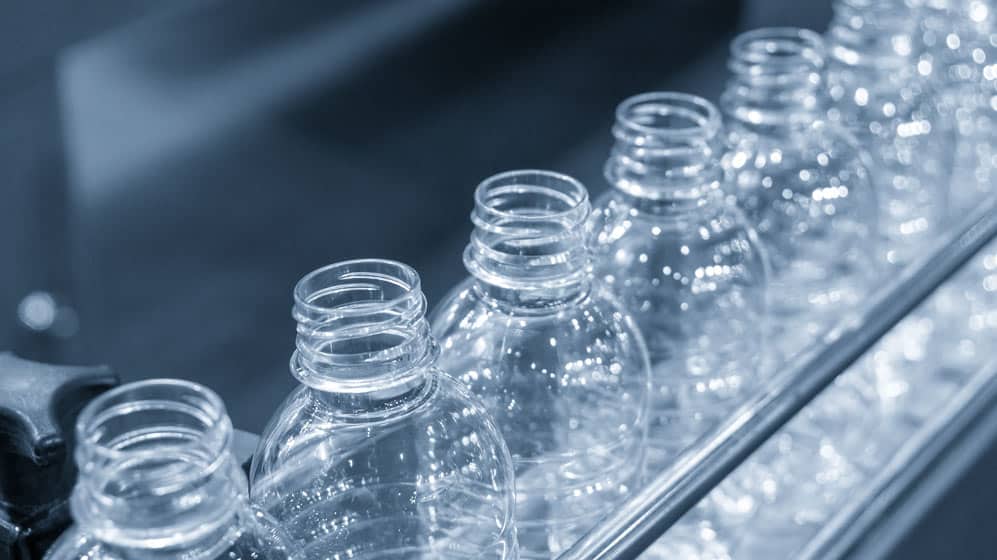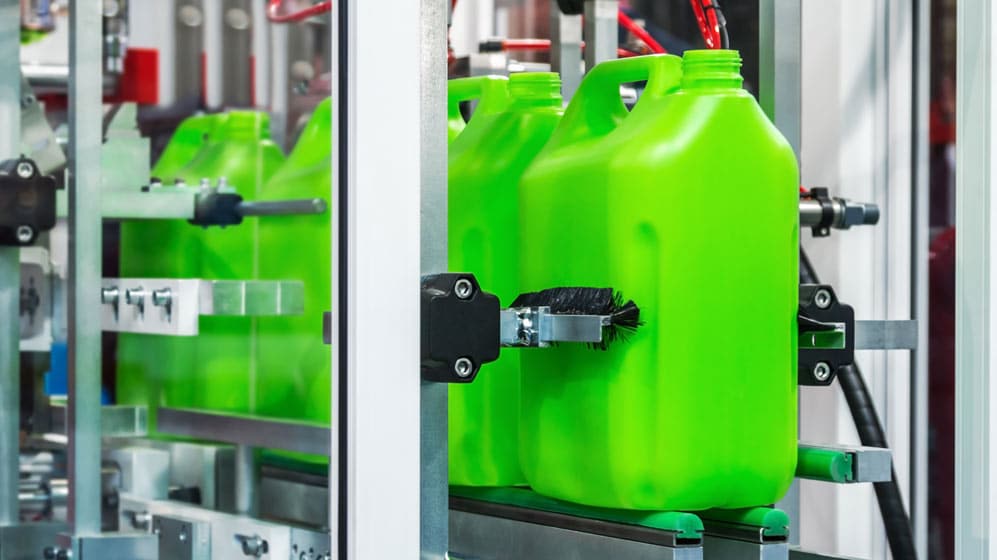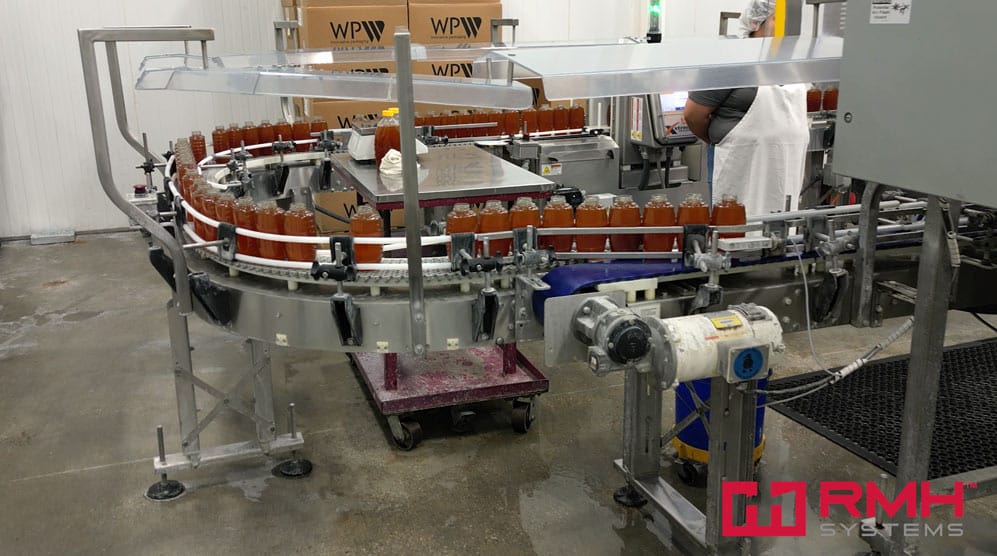Bottle filling machines, or liquid filling machines, have become an integral part of the industry, as they have revolutionized the way products are packaged and greatly improve production efficiency. These machines are designed to fill different types of bottles, jars, and containers with a variety of liquid and molten products. Automatic liquid filling machines are used in industries such as pharmaceuticals, food and beverages, cosmetics and many others.
Businesses are adopting liquid filling machines to improve their production lines and drive market growth. Increased awareness of the importance of hygienic and safe food and beverage products, as well as the rising demand for preservative products, are driving the adoption of liquid filling machines. RMH Systems can help you choose the right solution so you too can benefit from increased speed, accuracy, efficiency, and cost savings.
Benefits of Automatic Liquid Filling Machines

- Increased Efficiency: One of the primary benefits of using bottle filling machines is the increased efficiency they offer, as they’re designed to fill bottles in a fast and efficient manner. This increases the efficiency of production, and it also reduces the time it takes to fill each bottle manually.
- Accuracy: Another benefit of bottle filling machines is their high level of accuracy. They’re equipped with sensors that detect the level of the liquid or powder in the bottle, which ensures that the product is filled to the correct level. This eliminates the risk of under- or overfilling, which can lead to product waste.
- Cost-Effective: Bottle filling machines are also cost-effective in the long run. They reduce the cost of labor, as few or no employees are required to operate the machine, depending on the level of automation.
- Versatility: Bottle filling machines are versatile and can be used to fill different types of bottles and containers with products in different industries such as pharmaceuticals, food and beverages, cosmetics and many others.
Additionally, liquid filling machines can fill more than just bottles. They can also be used to dispense products into:
- Jars—jams, sauces and spreads
- Vials—chemical and pharmaceutical
- PET and HDPE jugs—agricultural chemicals
- Pouches—beverages, condiments and personal care items
- Tubes—toothpaste, creams and gels
- Ampoules—medications and chemicals
- Cans—food and beverages
- Cups—food and beverages

Types of Liquid Filling Machines
- Gravity Filling Machine: This type of filling machine is designed to fill bottles with thin liquids such as water, juice, or oil. The machine uses gravity to fill the bottles, and the liquid is fed into the bottle through a nozzle. The machine is easy to operate and can fill bottles at a high speed.
- Piston Filling Machine: This type of filling machine is designed to fill bottles with thicker liquids such as cream, honey, or shampoo. The machine uses a piston to fill the bottle, and the liquid is fed into the bottle through a nozzle. The machine is highly accurate and can fill bottles at a high speed.
- Overflow Filling Machine: This type of filling machine is designed to fill bottles with liquids such as detergent, shampoo, or motor oil. The machine uses a nozzle to fill the bottle, and the liquid overflows into a reservoir, which ensures that the bottle is filled to the correct level. The machine is highly accurate and can fill bottles at a high speed.
- Net Weigh Filling Machine: This machine uses scales under the containers to tare and measure in the correct amount of product weight into the container. These are extremely accurate and preferred if reducing product give-away is a high priority.
- Mass-Flow Filling machine: This type of machine measures the mass of the product passing through the fill nozzle, measuring the mass of the product going into the container. These are typically used in applications that require an accurate fill at a high rate.
Integrating Liquid Filling Machines with the Rest of Your Production Line

Fully automating your liquid fill line can help you streamline operations, reduce labor costs, and improve overall efficiency and product quality. Here’s how automation can help you further enhance your processes.
Conveyors
A conveyor system transports containers between different stages of the production line. Containers are typically loaded onto the conveyor either manually or automatically, depending on the scale of the operation. Conveyors are used to move the product containers, the cases that hold the containers, and the pallets that hold the cases.
Container Cleaning
Before filling, containers may need to be cleaned to ensure they are free from dust or contaminants. This can be done using air rinsers, vacuum cleaning systems, or container washing machines.
Bottle Cappers
After filling, containers move to the bottle capper station, where caps or lids are applied and secured. Capping machines can handle various cap types, such as screw caps, snap-on caps, or pump dispensers. The capping process can be fully automated, semi-automated, or manual, depending on the production scale and requirements.
Induction Sealers
Some products may require additional sealing, such as induction sealing or heat sealing, to ensure the product’s freshness and prevent leakage.
Product Labeling and Coding
Next, containers move to the product labeling station, where labels are applied to the containers. Labeling machines can apply different label types, such as wraparound, front-and-back or top-and-bottom labels. Product traceability and product coding systems can also print variable data, such as batch numbers or expiration dates, directly onto the labels or containers.
Inspection
Quality control systems, such as robotic vision systems or checkweighers, can be integrated into the production line to verify that containers are filled, capped and labeled correctly.
Packing and Palletizing
Finally, the containers are packed into boxes or cartons and prepared for shipping. Industrial packaging systems and palletizing robots can be integrated with the production line to automate these processes, ensuring efficient and consistent packaging.
Choosing the Right Filling Solution
When it comes to choosing an automatic liquid filling machine, there are several things to think about.
First off, you need to consider how much product you want to fill, so you can find a machine that can handle that amount. It’s also important to pick a machine that’s designed for the type of product you’re filling – whether it’s a liquid, powder, or cream. Plus, you want to make sure the machine can handle the size and shape of your bottles.
Accuracy is super important too, especially if you’re dealing with expensive products. You don’t want to waste any product or mess up any of the bottles. So, look for a machine that can deliver consistent and precise fills.
Another thing to think about is how easy the machine is to use and maintain. Nobody wants to spend hours figuring out how to operate it or clean it. And of course, the cost is always a factor. You want to find a machine that fits your budget but still gets the job done right.
Lastly, make sure you choose a machine from a reputable manufacturer. You don’t want to end up with a lemon that breaks down after just a few weeks. Check out the company’s history and read some reviews before deciding.
Make sure you work with a turnkey industrial integration company like RMH Systems who can provide filling solutions tailored to your specific needs, as well as any future service and maintenance needs.
Need help with automating a liquid filling line? RMH can help today! Schedule a free consultation today!